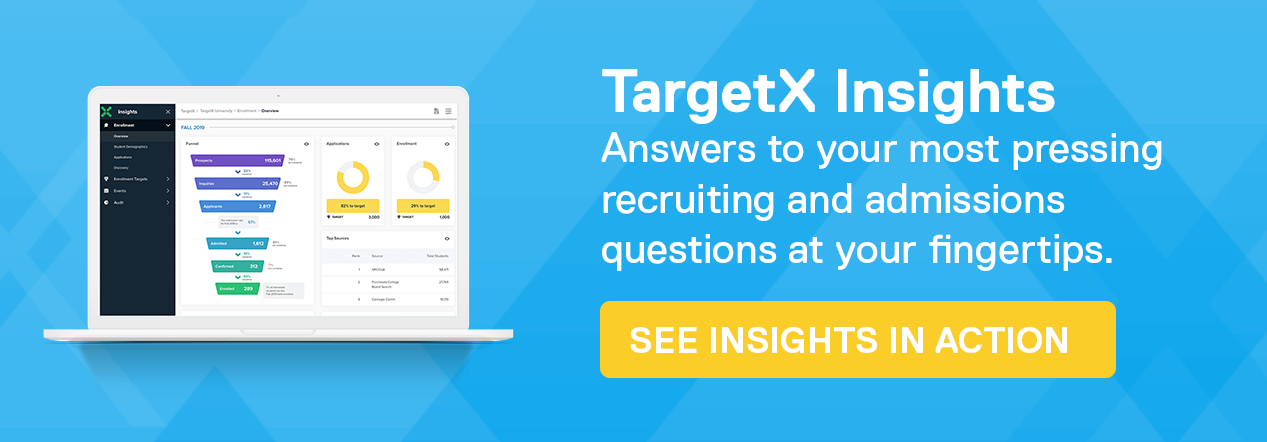When I was in kindergarten, one of our art projects was to paint a self-portrait of ourselves as what we wanted to be when we grow up. Kids painted themselves as teachers, firefighters, astronauts – all kinds of career dreams were in their infancy in that class. (I painted myself as a singer-slash-hair-stylist. Neither of those have come to fruition.) This may be surprising, but not a single one of my classmates painted themselves as a strategic enrollment management professional. And yet, many of us – yourself included – have found our way into this profession. Welcome! After almost a decade in the field myself, I can confidently say that I really think you’ll like it here.
You may have come from a different role in admissions, another department or division in higher education, or another industry entirely. You may have taken some courses in higher education leadership, or you may be drawing from your experiences in other areas. Whether you’ve been in your position for about ten minutes and are looking for guidance, or have a few more months under your belt and are looking for markers to validate that you’re on the right track, you’ve ended up in the right place. Here are five main areas to pay attention to as you get your bearings:
1. Mission and vision of your institution – What kinds of students are you looking for?
Whether you’re working at a large undergraduate school or a small community college, the mission and vision statements of your institution will provide invaluable guidance to you in your strategic enrollment practice. If your school aims to produce leading researchers and scholars in a specific field, your enrollment management efforts will look a lot different from a school who wants to provide a wide range of support to a local community. As early as possible, get familiar with your school’s mission and vision statements. They’ll provide insight into larger institutional priorities, and a framework for you to make decisions as you dig in to the work of building your student body.
2. Strategic plans including growth goals and targets – How many students do you need to get and how fast do you need to get them?
It’s impossible to get too far into the enrollment management career without realizing that there are many expectations placed on your efforts and outcomes. Sorting out what official strategic plans are in place, including any goals or targets for growth, will help to cut through the noise of all the voices offering opinions about how you should be spending your time or what you should be measuring. Your targets may be broad or focused in scope; they may be for your incoming class headcount or your total student population; they may come from your internal enrollment management team or from higher administrative bodies. Once you know the context of your plans and targets, you can organize the rest of your enrollment management efforts accordingly. This may mean extrapolating targets for the bottom of the funnel back up so you know how many applications you need to have, or it may mean focusing your dollars or time on a particular program. Regardless of the implications, you’ll be flying blind without knowing what your targets are.
3. Resources – staff, tools and budgetary – What resources do you have to go get them?
Speaking of dollars and time… You can’t build an enrollment management operation without knowing what resources you are working with. Your team is easily the biggest resource at your disposal, and while you certainly know who they are, it’s worth taking the additional time to figure out how best to use them to achieve your enrollment goals. Beyond your specific team, the other people at your school are also resources you can plan on using – like the marketing department, faculty for profiles or communication with prospective students, and financial aid staff for providing early guidance to prospects. Finding your lines of collaboration and connection with other folks on campus can extend your personnel resources far beyond your formally defined team. Your tools are also a huge asset as you progress in your work. Using the best technology at your disposal (like the TargetX Recruitment Suite) can not only save you time – it can actually improve the effectiveness of your efforts. And finally, those dollars! Finding out what money you have to spend and what constraints you have on spending it is vital to maximizing your enrollment management efforts. Do you have a huge events budget? What does your budget for purchasing names from list sources look like? How much can your staff spend on travel to recruitment events and activities? You get the honor of putting all these resources to work building your incoming class.
4. Sources of students – schools, events, marketing – Where do these students come from?
Unless you are one of the very few enrollment managers to start from scratch at a brand new institution, the good news about this work is that you likely have some students currently enrolled at your school – and they all came from somewhere. Getting information about what recruiting efforts resulted in getting students enrolled in the past will give you a good sense of where they’ll likely come from in the future. What schools did students attend before coming to your school? What events did you host – on-campus or off – that prospective students attend? How did students hear about your school, and what influenced them to apply? Building on recruitment efforts that were successful in the past is a great place to start. As you compare your efforts from year to year, you’ll get increasing evidence about what things work and what things don’t – evidence that you can use to justify how you’re spending your resources to achieve the goals set up for you.
5. Get visibility – How’s it going as you go get those students?
All of the above elements are key to getting context for your enrollment plan. As that plan is executed, it is important to monitor how things are going in real time – especially since your final numbers of enrolled students won’t come in until the term starts. You need to know where to go get visibility into real-time data for your current recruitment cycle. Your enrollment funnel numbers, student demographics, progress to targets, event performance, and counselor / territory activity are all important factors to monitor throughout your recruitment and admissions cycle to be sure that your enrollment plan is being executed well. And if adjustments need to be made to any of your plans mid-stream, you need to be able to make data-informed decisions instead of giving it your best guess. If you’re coming into an enrollment management operation that hasn’t tracked these elements before, do your future self a service and make good plans for collecting all this information for the current cycle so you can compare going forward.
This may seem like a whole lot of ground to cover. (Or it may seem like no-brainer information – if that’s where you’re at, well done!) The good news is that you’re not alone – there are people who want to help you and help you succeed. You may have already discovered this, but as an enrollment management professional, you’re often operating in the “in-between” spaces. You get to listen to and tell wonderful stories about students’ experiences, all the while backing up those stories with hard statistics and data. You represent your institution to people who are outside of it, and present information about those interactions back to your internal stakeholders.You get to think creatively, but always with your real-world constraints at top of mind. As you are negotiating the back-and-forth between all these variables, it’s important to utilize the best tools at your disposal to organize the wealth of information you are collecting and to communicate the clear story of the work you’re doing. TargetX Insights is one resource you can lean on to help you tell that story.
In TargetX Insights, your real-time enrollment funnel information can be viewed at the tip of your fingers without having to run a report – and it’s visually digestible, so when you need to show your information to any of your invested colleagues, they can see and understand exactly what is going on. You can enter your targets and monitor your progress toward them throughout the recruitment cycle – even for specific student populations or programs. All of the information you have about your events is not only easy to access – it’s now connected to your funnel information so you can see precisely what impact events have on your prospective students. You can see how the demographics of your incoming class fit your strategic goals, how effective your sources are at providing names of students who match what your school is looking for, and soon you’ll be able to see how your whole team of counselors are performing in their individual areas.
You’re part of a community now, with shared joys and challenges, and we’re glad you’re here. If there’s anything that our team here at TargetX can do to support you in that, don’t hesitate to reach out.

